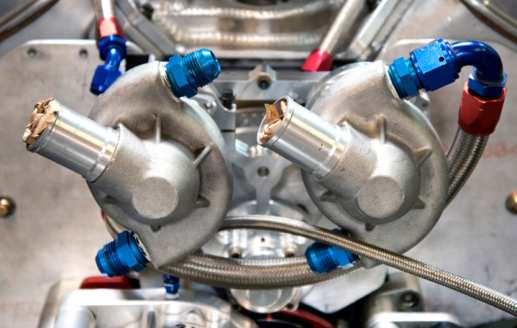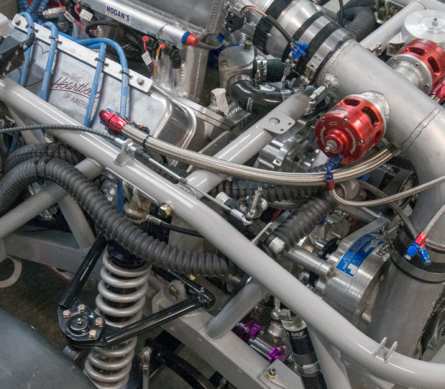Water System: Land Speed / Top Speed Setup

The Land Speed/Top Speed shelves are full of lead weights, cooling hoses,
specially modified control arms, and The Elephant’s air-filter assembly. The
cooling hoses on the shelf aren’t extra; every one of them is installed when the
crew installs the Land Speed/Top Speed cooling system. The hoses are connected to the ends of aluminum cooling pipes that tuck up under Big Red’s rocker panels.
The system uses two Stewart Components’ electric 55-gpm (gallons per minute) water pumps that push water (not coolant) from the tank to the engine in the front of the car. The hoses and pipes that feed water to the engine run down the passenger side of the car, close to the exhaust system near the rear suspension. These areas close to the hot exhaust were wrapped for thermal protection. The team constantly had cooling problems when they were running two CSR remote electric pumps in the rear…and nothing else. After some cooling problems, they
came to the conclusion that the CSR pumps just couldn’t move the water to the front fast enough during hard acceleration. The attempts at 250-mph-plus passes were just too much for the setup. When the CSR pumps weren’t working well any longer, Dave replaced them with Stewart Components’ remote water pumps in early 2015. Those worked okay, but still not well enough. Their 55 gpm just wasn’t getting it done. In September 2015, the team installed an RCD Engineering camshaft-driven tri-drive with two KSE Racing water pumps.
The KSE pump pulls water from the rear, while the Stewart pumps in the rear are pushing. The KSE pumps push water into the block and back out through the aluminum hose adapter bolted on the intake, where a water neck normally would be mounted. From there, the water is pushed through hoses and pipes running down the driver’s side of the car under the rocker panels and up into the top of the water tank. Since the team swaps the setup from Road Race to Land Speed/Top Speed mode on a regular basis, they label all the hoses in the system. The R.O. is for return outside and R.I. stands for return inside. All of the hose connections use stainless-steel T-bolt clamps. These clamps give uniform sealing pressure 360° around the hose, where standard worm gear clamps do not. The top of the water tank easily is identifiable compared to the fuel cell, by looking at the 1.5-inch water hoses that

dump into the tank from the top. The fuel cell has much smaller hoses plumbed in the top. Overall, the water system holds approximately 45 gallons of water. At 8.34 pounds per gallon, the water alone weighs 375.3 pounds. Then add all the extra weight of the components involved. Luckily, Land Speed/Top Speed setups don’t always need to be running lightweight.